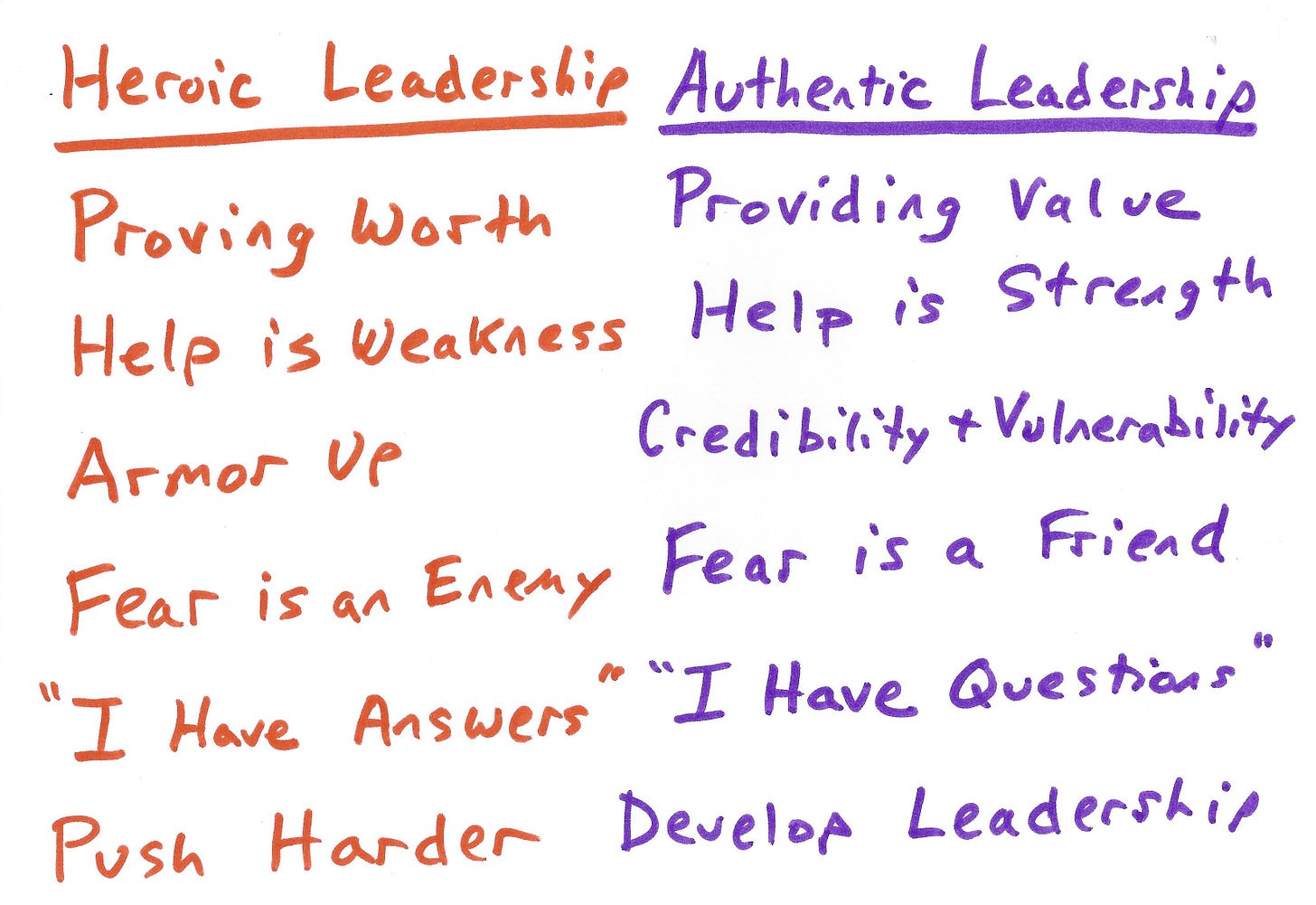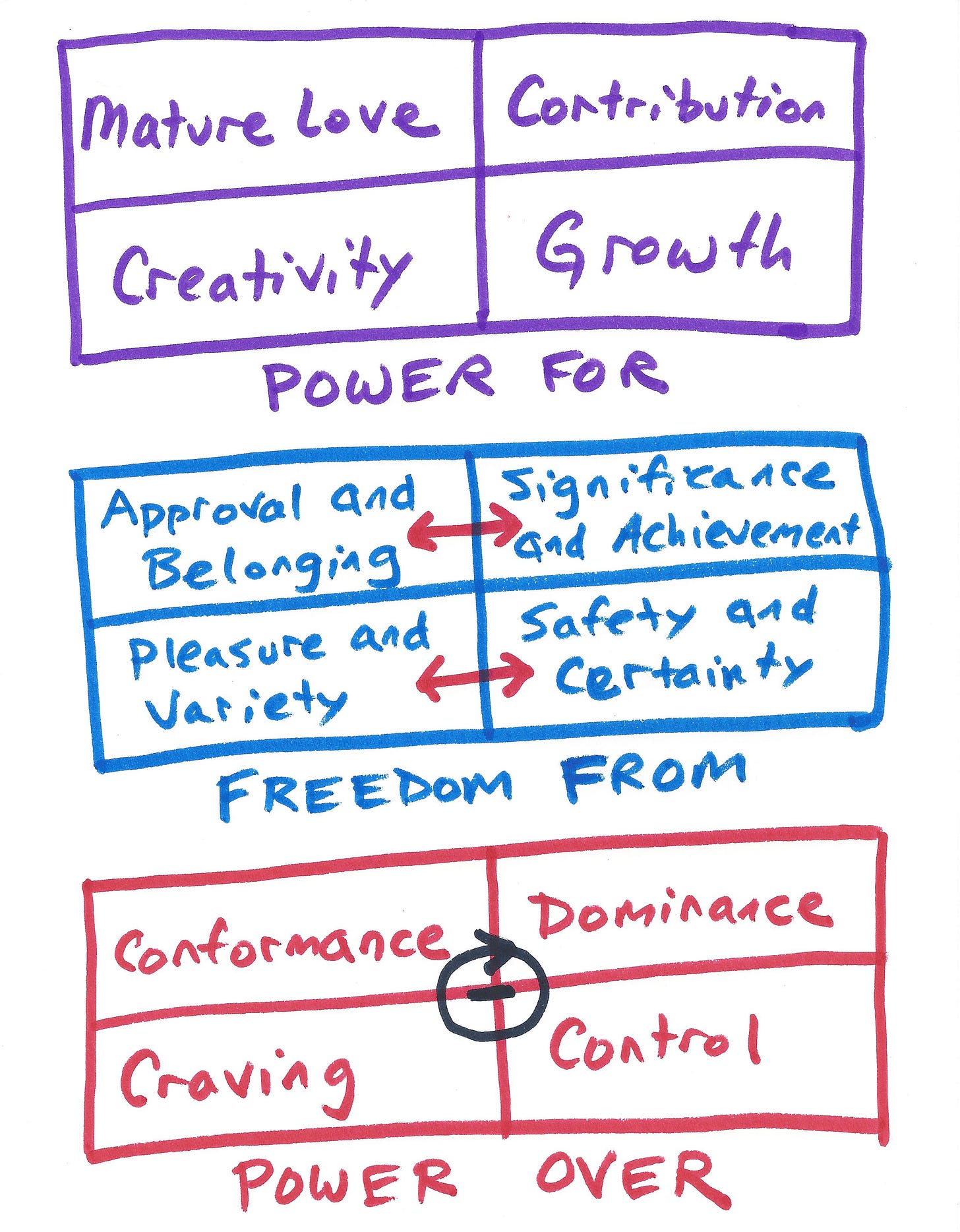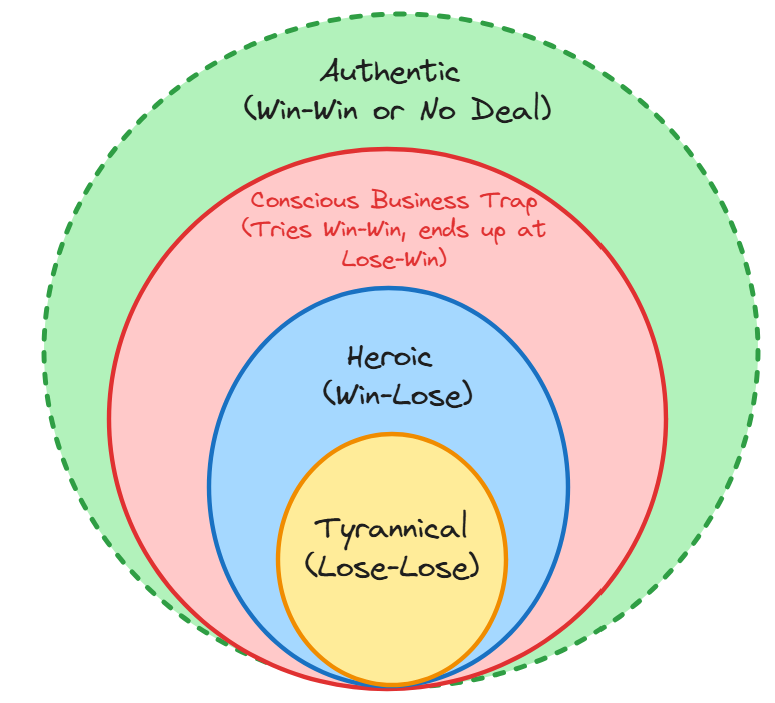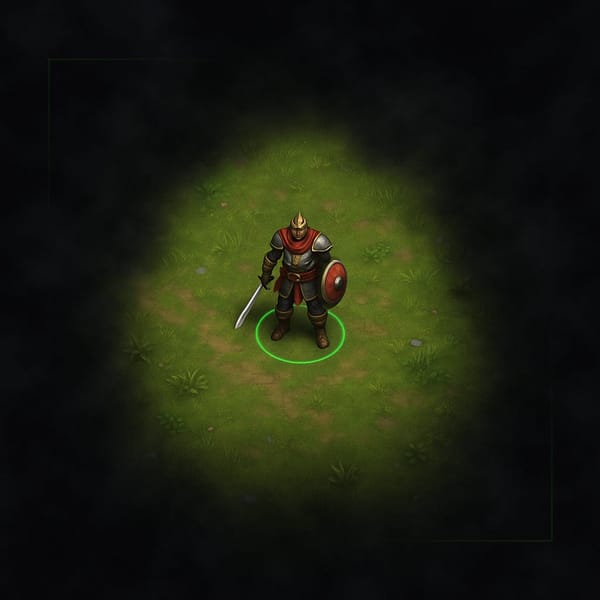A Playbook for Real Leaders

[This article has a 5/10 Woo Rating]
This is a standalone Part 2 of my conversation with founder and coach Brian Whetten (Part 1 is here). In this conversation we explored a new kind of leadership. It’s a growth path that remains fully within your control, even in chaotic times, and it brings significant benefit to yourself and those around you.
This article is divided into three parts: first, we’ll define what authentic leadership is and outline the path to it. Then we’ll explore a common trap along the way. Finally, we’ll share a practical playbook for putting authentic leadership into action. But readers will miss the full benefit of a rich discussion with over fifty supporting slides. You can watch below or listen on Spotify or Apple Podcasts.
Part 1: The Path to Authentic Leadership
Hundreds of thousands of people feel trapped in unfulfilling corporate jobs, torn between pursuing purpose-driven work or reviving their current career path. The key to resolving this tension is learning how to shift from heroic to authentic leadership.
Part of the reason many people get stuck is that we’ve been using an outdated definition of leadership. Brian calls this old version “heroic leadership.” It’s baked into our movies, books, political and corporate narratives. It says: prove your worth by overcoming, killing and conquering. For many people, relative success is never enough: there’s always somebody with more, who has done more. Heroic leaders tend to eventually burn out or hit a wall in their personal growth. Moreover, this entire mindset is increasingly losing its effectiveness in a chaotic world. We can either spend the next few years passively watching heroic leaders fail, or we can actively pursue the path of authentic leadership.
As you become more conscious, you become more aware of the inherent futility of heroic leadership and its draining zero-sum games. The next step is to start looking for win-wins and your own revitalizing infinite games. Authentic leadership centers on providing value not proving worth. It’s grounded in openness, vulnerability and making space for fear, rather than fighting it. Killing all the Russians in New York doesn’t bring John Wick’s wife and puppy back, whereas Neo becomes more powerful by integrating Agent Smith.1

To make this path more tangible, Brian uses a framework that maps leadership mindsets into three distinct modes. Each level has exponentially higher power, awareness and energy. The red boxes are tyrannical lose-lose, the blue are heroic win-lose and the purple are authentic win-win.

For example, look at the top right of each box (Dominance, Significance & Achievement and Contribution). We all have a need to be special. The question is, how do we get that need met?
- If you try to feel special by dominating others, you create a lose-lose. Tyrannical chimps eventually get ripped to pieces by alliances of their competitors. Not many dictators seem especially happy or die serenely in their beds surrounded by family.
- The heroic, win-lose iteration of control is achievement. Because everything you do is relative to others, somebody has to be below you for you to be happy or above you for you to feel motivated. This eventually leads to an energetically-draining sense of “never-enough.”
- The win-win dynamic is contribution: you find a way of producing real value that makes you and everyone else happy.
The problem is that there’s a trap at one specific stage of conscious development, for both individuals and businesses alike.
Part 2: The Conscious Business Trap
Both individuals and companies can move from tyrannical leadership (lose-lose), to heroic leadership (win-lose) to benevolent leadership (attempting a win-win). The problem with playing cooperative games in a competitive system is that you’ll persistently be taken advantage of (lose-win). This is the “Conscious Business Trap.”

In business, this trap leads to “conscious capitalists” that either have to sacrifice themselves or their ideals to survive in the zero-sum market economy. For individuals, this benevolent leadership trap means choosing self-sacrifice over contribution. I personally spent a number of years bouncing from pursuing careers in hospice work, social work and therapy because I felt called to service. But I didn’t enjoy any of them and they would have put my family at serious financial risk: it was pure self-sacrifice: lose-win. In contrast, contribution is creating value for others and having a lot of fun doing it.

The key to authentic leadership is to seek “win-win or no deal.”
Dictatorships rely on the intelligence of one flawed individual. The heroic win-lose iteration of capitalism is so much more powerful because it aggregates the intelligence of all the market’s participants. Authentic leadership is exponentially more powerful even than heroic leadership because draws from an external energy source rather than just your own willpower. It’s the missing ingredient added to the top four boxes (mature love, contribution, growth and creativity). But, at this transitional moment, this kind of love-power2 currently requires a safe space to flourish. It has to be protected from win-lose dynamics through a contract, community or a walled garden.
How does “win-win or no deal” resolve the tension between choosing a purpose-driven career change or revitalizing your current path?
The first answer is to look and see if it’s possible to get to those top four boxes within your current job. In our conversation, Brian tells the story of multiple authentic leaders who have produced exceptional business results through “win-win or no deal.” Often this requires ring fencing your business unit within the company or orienting it towards quality metrics.3 He tells a counterintuitive story about the appellate attorneys at one of the most prestigious law firms in the country. He asked how they “beat” opposing lawyers in court. One partner replied that trying to beat the other attorneys was a fool’s game (win-lose). Instead, they succeeded by making arguments that serve the court; they’re not crafted to attack the opposition, but to support the legal system and help the judge arrive at the best decision (a win-win).
If you can’t get to authentic leadership in your current career, another path is to quit and pursue purpose-driven work. For example, part 1 of our conversation focused on how to get started as a coach. Coaching offers a practical example of how “win-win or no deal” should be embedded directly into your business model. It’s why you spend the bulk of your time qualifying clients before they commit financially. If you can’t seek a win-win in the relationship, the coach needs to have the integrity to walk away before money has been exchanged. If you can find the win-win, the relationship produces real value.4
Within traditional businesses and careers, the “no deal” dynamic is still sadly hard to find in a win-lose economy. Most of us can’t afford to simply “walk away” from our jobs and responsibilities. So one secret is to create walled-garden private communities, like the one I’ve founded. You can pursue the path of authentic leadership without hastily quitting your job. These spaces allow for protection and mutual self-development because you can be sure everyone else is also seeking win-wins. “No deal” means people still playing win-lose will get weeded-out of the garden.
Whether within their companies, relationships or communities, the next generation of leaders are going to be creating these safe, fertile spaces for other people. Brian’s definition of authentic leadership is that it “takes responsibility for creating future growth with integrity.” They are gardeners not warriors.
Part 3: So how do you do it?
For the “how” of becoming an authentic leader, Brian outlines fifteen different practical tips. This five minute clip rattles through them, but to get the full context you really need to listen to the entire masterclass.
Put simply: moving from tyrannical, to heroic, to authentic requires moving from being driven by fear to being driven by purpose. As you move further away from fear, your power and awareness both increase.5 Brian has a compelling framework that helps people identify scary “Yes, Yes, Hell No!” goals. Then he shows you how to “make friends” with those fears.6 This upgrades your fuel source from heroic fear-based effort to win-win purpose-based alignment. Brian says a key moment is when a client says “Well, I’ve never told anyone about this before, but what I really want is *this*.” Once that gold has been unearthed, they can both work together to formulate experiments to help manifest the inherent genius in his client. These kinds of experiments are the most powerful tool I’ve seen in my own experience in transitional coaching.7 Authentic leadership increases your passion, energy and motivation while paradoxically decreasing how difficult your life feels.
For me, the critical difference is that heroic leadership focuses on goals and authentic leadership focuses on processes. Creativity, contribution, mature love and growth are all worth pursuing for their own sake. It can be paralysing to focus on the transcendent goal or job title that will make you happy. Instead it’s healthy to ask what positive-sum processes you could sustain indefinitely. As I’ve noted before, it’s been a useful framing to seek a routine that incorporates head, heart and body (or combinations thereof).8 My own day has spontaneously evolved into a mix of reading & writing (head), Brazilian Jiu Jitsu (body) and 1:1 meetings or time with my family (heart). All three are win-win: I only write about topics that readers tell me they care about, while I hope both my sparring partners and conversational partners benefit from the exchange. It shouldn’t be thermodynamically possible for both people in a dialogue to emerge energised. But that’s what differentiates purpose-driven authentic processes from heroic goals.9 It’s nearly impossible to burn out playing an infinite game. Perhaps the most helpful way to start on the authentic leadership path is to pay increasingly close attention to how much energy a process gives you.10
I’ve been coaching people in transition for a few years now, so I’m often asked how you find a more meaningful path in life. The truth is that everyone’s niche is shaped by their unique gifts. But, looked at broadly, evolving our consciousness appears to be the central purpose of our existence. Authentic leadership is a concrete framework for that process. Whether for yourself or others, it’s a path that always seems to result in surprising abundance and joy.
[Watch or listen to the full conversation on YouTube, Spotify or Apple Podcasts].
1 If you’d like more explanation of the Agent Smith dynamic and Matrix comparisons, here’s my longform article for Epsilon Theory about how Neo’s hero’s journey is a metaphor for the transition in consciousness.
2 Dr. Julia Mossbridge explained the science of unconditional love and power to us in more detail.
3 Here’s a recent article with more context on what that means, especially the concept of “dynamic quality”
4 Check out Part 1, Four Steps to Thriving as a Coach.
5 Can't stop thinking about an idea after my interview with
The Fourth Way. Riffing on Donald Hoffman's interface theory: when it comes to how we interpret the world there seems to be a trade-off between fitness and accuracy.
“Evolution has shaped us with perceptions that allow us to survive. They guide adaptive behaviors. But part of that involves hiding from us the stuff we don’t need to know. And that’s pretty much all of reality, whatever reality might be. If you had to spend all that time figuring it out, the tiger would eat you."- Hoffman
The implication being: the more scared you are, the less of reality you can see. Hence as we have moved into a more abundant environment, we will see more and more of "true reality."A huge part of this, IMO is that some people will increasingly realise there is a cooperative, holistic force beyond competition. People that remain too scared, intellectually LH-locked or traumatized will still seek short-term zero-sum interactions. People that can relax and open their doors of perception will be able to be guided by that force into longer-term positive-sum interactions.
6 As he said in our conversation last year, Brian believes the process of “making friends with your fears” is revolutionary. He also argues that ~99% of therapists, coaches and teachers are getting this wrong. The specific exercise is available in the free workbook to accompany “Yes, Yes, Hell No.”
7 Check out my interview with Anne-Laure Le Cunff and her excellent book Tiny Experiments for more detail.
8 Check out my recent mindblowing interview with The Fourth Way.
9 Zero-sum games are entropic and infinite games are syntropic.
10 Here’s my listicle of all 11 practices that emerged from last year’s Accelerating Wisdom Series. The energy diary is a key way to start.




